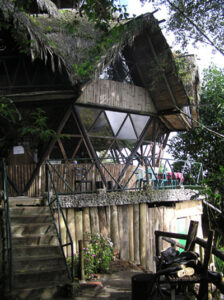
What could be more beautiful and bizarre than living inside a cloud? The residents of the Ecuadorian cloud forests do that every day!
The Ecuadorian cloud forests cover both sides of the Andes, high above the rain forest below. Warm, moist air travels up the sides of the mountains from the rain forest and condenses to form a thick layer of clouds on the mountain slopes. The cloud cover creates a different climate from the flat rain forest. It is still moist, but due to the high altitude, it is not as hot as the rain forest.

Richard Brommer
A visitor to a cloud forest reserve in Ecuador can experience life in an ecological tree house like this one.
Mosses and exotic plants thrive in the cloud forest. So do many beautiful and unusual birds. In fact, 60 percent of South America’s bird species live in Ecuador, and most of them are found in the cloud forest—especially hummingbirds, which co-exist with the cloud forest’s air plants.
Ecuador has established individual reserves, such as the Intag, Mindo-Nambillo, and Santa Lucia Cloud Forest Reserves, to help protect the cloud forest, where reforestation has been identified as one of several ecological goals. Replanting to replace harvested hardwood trees has become an important task.
The cloud forest reserves are popular vacation destinations for ecotourists. Their visitors can hike, swim, ride horses, mountain bike, climb mountains, admire waterfalls, and visit archaeological sites. Bird watchers and plant lovers can capture incredible photos. And the dreamer who only wants to know what it’s like to walk in the clouds just has to step out the door! Follow the link below to explore images of the cloud forest in Ecuador!
Explore More:
Go online to find out about volunteer organizations working to conserve the cloud forest in Ecuador. Explore the opportunities that knowing Spanish creates for someone who wants to live and work in the clouds. You may even want to write an e-mail (in Spanish, of course!) to one or more of the organizations requesting information. Then, present the information in Spanish to your class.
Share What You Know:
- Cloud forests exist all over the world. Research cloud forests in other countries of the Spanish-speaking world and share their names and locations in Spanish with your class.
- Try to grow an air plant from the Ecuadorian cloud forest. These plants grow on tree branches and get their moisture from the surrounding air. You can get information at a greenhouse or online about the special conditions you will need in order to grow an air plant successfully. Bring a photo of your plant to class and describe it in Spanish. Share the photo with your science class and describe the environments you had to create to mimic the plant’s native environment.
- Research the hummingbirds of Ecuador and, in Spanish, share with your classmates some of the facts that you have learned.